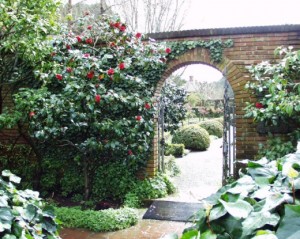
The new aesthetic in garden design features graceful silhouettes, strong shapes, and sculptural lines.
Each decade brings a new trend in gardening. The ’80s were characterized by exuberant color with mass plantings of annuals and the introduction of many new exotic plants into the market. The ’90s developed as the decade of perennials. Ornamental grasses, Hostas and native species became fashionable flora. The color was still an important aspect of garden design, but the focus shifted from flower to foliage color. Plants with chartreuse, dark purple or variegated leaves became the rage.
The current trend in garden design is planted composition and form. This new aesthetic advocates plants with a strong structure or graceful silhouettes. Plants are prized for their architectural shapes much like sculpture. Planting is less dense so that each individual plant or grouping of the same variety is surrounded by blank space that defines its outline.
This simplified design style reflects the principles of the Arts and Crafts movement: clean lines, beauty in structure and materials that echo the native environment. Creating a setting that shows off the natural form of every plant and harmonizes with the surroundings.
Strong Forms
If you were able to take a black and white photograph of a typical perennial border, it would be hard to distinguish the different plants included. Large drifts of each variety, planted closely together, are characteristics of the design. Without flower and leaf color as a clue, the lines between various spaces are blurred. But plants that are recognizable by their shape and structure more than their foliage and flower color stand out even in gray tones.
Plants With Structural Shapes
Clumping Bamboo grows in several different heights and is not invasive like its running cousin. Erect, segmented stems become bare at the bottom over time, creating an interesting look. A row of clumping bamboo makes an effective screen or hedge, and a single plant becomes a graceful accent.
Agaves and Yucca are gaining popularity for their drought tolerance and low maintenance as well as their graceful arching and sword-shaped leaves. Many varieties display showy flowers on tall spikes. Due to their large growth and strong shapes, they are usually planted as solitary specimens.
Ornamental grasses continue their reign as garden favorites in this current design trend. The stiff, upright growth of Feather reed grass, the fine drape, and the way of Mexican feather grass or the elegant curve of Maidengrass all exemplify architectural qualities.
Tall Spikes covered in pale flowers rise above shiny dark green, deeply lobed clumps of leaves on bear’s breeches. The combination provides a striking accent in a partially shaded area.
The big, bold foliage of tropicals like bananas, palms and elephant ears will become more available to gardeners in less temperate climates to use as a seasonal structure in the landscape.
Texture
Peeling or rough bark or exceptionally smooth trunks on deciduous trees and shrubs fit into the modern gardening style. Heavily crinkled or wavy leaves also display a high textural quality. Hosta breeding already embraces this trend toward rough leaf surfaces.
Size
Size does matter in the modern garden. A single, large plant becomes the focal point of an expansive landscape. However, the downsizing of modern yards has not been ignored. Many new dwarf shrubs and trees are now available as growers develop these structural elements in smaller sizes.
The bed size is shrinking as well. Smaller yards and individual plantings call for diminutive gardens. Look for longer, thinner planting beds with a limited number of individual plants and more visible mulch.
Low Maintenance
The perennial craze of the last decade was partially fueled by the mistaken notion that planting perennials would cut down on garden work. But perennial gardeners soon realized that not replanting every year did not equate to fewer chores in the garden. Perennials need regular maintenance to stay looking good: deadheading, dividing, and pruning.
Many of the current popular foliage plants require little maintenance when planted in the right location. Succulents need excellent drainage, so good soil preparation is very important. Natives of the tropics like lots of suns and many need protection from strong winds and frost. (By the way, has this been the windiest year ever or what?) Site them correctly and they will reward you with stunning good looks and little care.